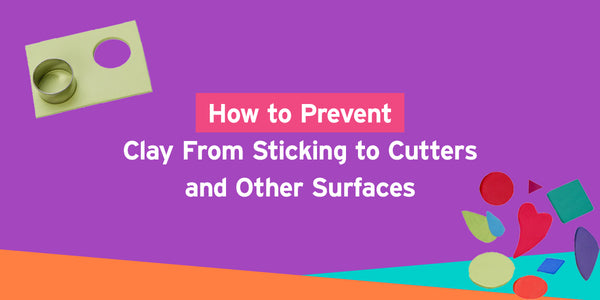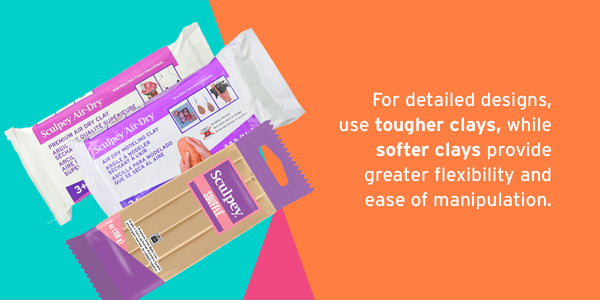
Are you tired of wrestling with your polymer clay each time you try to cut out those perfect shapes for your latest project? Well, you're not alone. Working with polymer clay is exciting, but one small challenge is preventing it from sticking to surfaces. Sometimes, clay seems to have a mind of its own.
It all comes down to clay's unique composition and properties, including its tendency to soften and become clingy when handled. There are also other factors like temperature and moisture content to keep in mind.
Fortunately, we have a few simple tricks on how to keep polymer clay from sticking to cutters, surfaces and your hands, so stick around — pun intended — and learn the secrets to hassle-free crafting.
Tips for Keeping Clay From Sticking to Cutters
Crafting with polymer clay can be a blast, but let's face it — having clay cling to your cutters can be frustrating. Here are a few tried-and-true fixes to consider.
Use a Release Agent
One of the simplest methods to keep clay from sticking to your cutters is to use release agents. Cornstarch or baby powder are great options, creating a barrier between the clay and the cutter. This thin layer allows for easy release while maintaining the integrity of your creations.
Try Plastic Wrap
For a different approach, try placing a piece of plastic wrap between the clay and the cutter. Plastic wrap is an excellent way to prevent clay from sticking to cutters while enhancing the final appearance of your creations. It slightly compresses the clay, which can help you get smooth, rounded edges.
Chill the Clay and Cutters
Another excellent strategy is to stiffen and chill your clay and cutters before use. Place them in the freezer for several minutes to help reduce stickiness and make cutting easier. Avoid keeping the clay in the freezer for too long — clay that is too chilled might become brittle and prone to cracking.
Clean Your Cutters
Keeping your cutters clean and well-maintained is essential for smooth cuts and preventing clay buildup. After each use, clean your cutters with a moist towel or baby wipe to remove any remaining clay. A moderate scrape with a soft-bristled brush can do wonders to help remove stubborn residue.

Pay Attention to Clay Characteristics
Polymer clays differ in their stickiness and workability. When choosing your clay, consider its properties and how they may affect your cutting process. For detailed designs, use tougher clays, while softer clays provide greater flexibility and ease of manipulation.
Note Your Cutter Type
Some cutter materials and designs may be more susceptible to clay stickiness than others. For example, cutters with rough or textured surfaces may cause the clay to cling. Meanwhile, smooth, nonporous cutters tend to release the clay more easily. Plus, the sharpness of the cutter's edges can impact its ability to cut cleanly through the clay without adhering. So, try using high-quality clay cutters made of materials such as stainless steel or plastic.
How to Prevent Clay From Sticking to Surfaces
Now that you know how to prevent clay from sticking to your cutters, let's dig into how to prevent clay from clinging to your work surfaces.
Use a Non-Stick Work Surface
First and foremost, use non-stick work surfaces to ensure a smooth crafting session. Whether it's wax paper, aluminum foil or the Sculpey Tools™ Oven-Safe Work Mat, these surfaces create a barrier between your clay and the underlying material. Non-stick work surfaces can thus reduce stickiness, making cleanup a breeze.
Sprinkle Cornstarch or Talcum Powder
When in doubt, dust it out! Sprinkling a little cornstarch or talcum powder on your work surface before diving into your clay creations can help prevent sticky situations. A light dusting creates a barrier that minimizes contact between the clay and the surface, leaving things slick and mess-free.
Condition the Clay
Conditioning your clay properly can add texture while being your secret weapon against stickiness. Knead your clay until smooth and pliable. This extra step improves workability while reducing the clay's inclination to stick to your crafting surface.
Roll out the Clay
Using a clay roller or brayer can help create a smooth and level surface when working with polymer clay. Roll out your clay on a non-stick surface, then lightly dust the clay roller with cornstarch or talcum powder to prevent sticking. This trick also ensures your clay stays where you want it during shaping and crafting.
How to Prevent Clay From Sticking to Your Hands
When clay sticks to your hands more than your project, it can quickly ruin the fun. Here are a few handy tips to prevent this from happening — pun, once again, intended.
Keep Your Hands Clean
Keeping your hands clean is essential to preventing polymer clay from sticking like glue. Before plunging into your clay creations, wash your hands well with soap and water to remove any dirt, oils or moisture that may exacerbate sticking.
Use Gloves
If you're constantly dealing with sticky fingers, consider wearing gloves or applying a barrier lotion before working with clay. These protective measures form a barrier between your skin and the clay to reduce direct contact and stickiness.
Try Different Molding Techniques
You can try a couple of clever techniques to help you handle clay without it adhering to your hands. To avoid sticking, shape and manipulate clay with light finger dabs or rolling motions rather than pressing or squeezing.
The Sculpey Experience
When it comes to polymer clay crafting, Sculpey has a wide choice of products designed to improve your creative journey. For the greatest non-stick experience, we recommend Sculpey®'s creative clay lines, each with its own qualities and applications.
- Original Sculpey®: Perfect for beginners and seasoned crafters, Original Sculpey® is a versatile clay that bakes to a smooth, matte finish. Its pliability and minimal stickiness make it ideal for intricate detailing and sculpting.
- Sculpey III®: Known for its vibrant colors and soft texture, Sculpey III® is a favorite among crafters for its ease of use and excellent adhesion properties. It's great for creating jewelry, figurines and decorative pieces.
- Sculpey Premo®: Offering enhanced durability and flexibility, Sculpey Premo® is ideal for advanced crafters and jewelry makers who need high-quality results. Its firm texture and superior strength make it perfect for intricate designs and intricate cane work.
- Super Sculpey®: Designed for professional crafters and model makers, Super Sculpey® combines the strength of polymer clay with the smoothness of ceramic clay. Its non-stick surface and fine details make it the go-to choice for creating lifelike sculptures and prototypes.
Allow Sculpey to Supply You With the Clay and Tools You Need
Learning to keep polymer clay from clinging to cutters, surfaces and hands is essential for a smooth and hassle-free crafting experience. Simple strategies like using release agents, keeping surfaces clean and choosing the correct type of polymer clay will help you take your creative projects to new heights.
With Sculpey's range of polymer clay options, crafters can access high-quality materials designed to enhance their crafting experience. Whether you're a beginner or a seasoned crafter, we have the perfect clay product for your needs.


